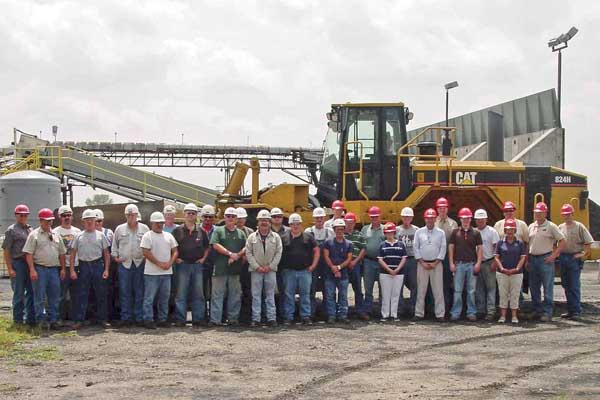Top Plants: Hutsonville Power Station, Crawford County, Illinois
Owner/operator: AmerenEnergy Generating Co.
This plant’s staff proves that a can-do attitude and high productivity can be compatible with a safer workplace. The proactive approaches they used at the 162-MW Hutsonville plant ranged from improving boiler efficiency to better managing risks to workers.
One of the greatest challenges facing the U.S. electric generation industry is reconciling the dual imperatives of profitable business practices and strong workplace safety. The dedicated staff at the Hutsonville Power Station (Figure 1), located in Hutsonville, Ill., have taken on this challenge and successfully worked together to increase their facility’s efficiency while looking out for their fellow workers.

1. Energizing Illinois. An aerial view of AmerenEnergy Generating’s Hutsonville Power Station on the Wabash River, southeastern Illinois. Courtesy: Ameren
Every day the close-knit group of employees at the Hutsonville plant demonstrate their leadership skills in the safety arena by articulating and acting on their strong belief in the importance of workplace safety — and then being held accountable for the results.
In May, along with the 2009 ELECTRIC POWER Conference and Exhibition held in Rosemont, Ill., the PRB Coal Users’ Group (PRBCUG) conducted its annual meeting. Each year the group recognizes one or two PRB Coal Plants of the Year for their innovation and implementation of "best practices and best available technologies." (See also the large plant profile on p. 46.) These plants are inducted into the Power Plant Hall of Fame. Selections are made by the board, with input from the group’s members. PRBCUG members include current and prospective users of PRB coals. Associate members from companies supplying coal, equipment, or services also participate in the selection process.
Hutsonville’s Story: Attitude, Communication, and Culture
Bob Taylor, former PRBCUG chairman, presented the award to members of the Hutsonville staff at the 2009 PRBCUG Awards Banquet in May. He pointed out that this was the first year that Ameren’s Hutsonville Power Station had been nominated.
"Ameren’s Hutsonville plant is a smaller plant in size and one with a huge heart," Taylor told POWER in an interview in August. "They are a story of family. Whenever faced with uncertainty — first by the need to be price competitive in the changing market and, more recently, the whole discussion of where our industry is headed — they responded with the cohesiveness of family and plowed forward, always taking care of each other, their families, and business. They share a remarkable story of how to improve and make change and make it look simple."
He listed the top reasons that the Hutsonville plant was selected PRBCUG Plant of the Year in the small plant category:
-
"Can’t" isn’t in their vocabulary. When faced with an issue, whether it is figuring out how to eliminate a safety and health problem associated with underground reclaim tunnels, or not having enough money to implement the solution, they search for solutions.
-
Continual improvement. Whether it is improving the process for receiving coal by truck, effectively managing risks to workers, or improving boiler efficiencies, the plant personal have challenged themselves to find better ways while keeping it simple. Their gears are always turning, seeking improvement.
-
Building relationships. From elementary school to the workplace, many of the employees grew up together. They know each others’ families. Their family extends within the workplace and beyond. One example involves the time the plant was seeking solutions for the PRB coal conversion. Benetech listened and extended a hand to help build positive relationships that resulted in good harmony and effective resolution to what was perceived as a complex, far-reaching problem.
-
Simple solutions. They implemented a simple, yet effective method of placing coal onto a conveyor. It then travels through one station on its journey to the silos, and then through the mills, and into the boiler. Simple is good.
-
Success. Many would give up when faced with the uncertainty of today’s environment. Not the Hutsonville employees and their partners, who join together to overcome the tough obstacles and ultimately succeed.
-
Family. The plant’s staff is cohesive and always taking care of each other, their families, and their business (Figure 2).
2. The power behind the power. The reasons for the plant’s success: the employees of Hutsonville Power Station. Courtesy: Ameren
Plant Profile
In his interview with POWER in August, Greg Musch, the production superintendant at Hutsonville, described the operations of the 162-MW intermediate-load PRB coal facility. "The first unit at Hutsonville went online in 1940, followed by the second in 1941" he said. "Later, the 80-MW Unit 3 went online in January 1953, and the 82-MW Unit 4 went online in May 1954. Units 3 and 4 are GE turbines/CE tangential-fired boilers. In 1981, Units 1 and 2 were retired."
"Currently, there are 57 employees at the site," he said. "We have four operators and one supervisor per operating shift. That breaks down to three 8-hour shifts per day, seven days per week. In contrast, the coal-handling operations are different: two employees per shift with a single 12-hour shift per day, seven days per week. Finally, all support functions (maintenance, engineering, and administration) are normally carried out by our employees from Monday through Friday from 07:00 to 15:30."
The plant’s performance numbers are presented in the table.

Hutsonville Plant’s performance record. Source: Ameren
Adapting to PRB Coal
The first delivery of PRB coal to the Hutsonville plant occurred on September 20, 2004. It was used in a blend of 25% PRB and 75% bituminous coal once the Illinois Environmental Protection Agency (IEPA) permit requirements were met.
"The sulfur emission credit price escalation was one of the main driving factors that lead us to consider fuel flexibility options to keep the plant competitive," Musch said. "We petitioned the IEPA to include PRB fuels and blends in the plant’s operating permit prior to the changeover. In addition, we conducted unit particulate discharge stack tests on both units per the IEPA directive, which was part of the permit."
Before the switch to PRB coal, Hutsonville used high- and medium-sulfur bituminous coal from Illinois and Indiana. Currently, the plant is using 100% PRB coal.
Musch explained the timetable involved in transitioning to PRB coal at the plant:
-
The SO3 injection system was already in place, which permitted burning lower-sulfur local bituminous coals.
-
In the fall of 2004, the plant began using a blend of 25% PRB and 75% bituminous coal.
-
At the same time, plant employees implemented safety and hazard-elimination projects to permit handling of the PRB fuel.
-
Starting in the spring of 2005, the plant began using a blend of 75% PRB coal and 25% bituminous coal.
-
Beginning in the spring of 2006, the plant started using 100% PRB coal.
The total costs included $6.9 million for in-plant adaptations and $4.5 million for coal yard upgrades to permit the proper handling of PRB fuels. Total conversion time was four years, which included completing both in-plant and coal yard equipment upgrades.
Dealing with Fuel-Handling Challenges
Musch elaborated on the new fuel-handling challenges that plant employees faced after the switch to PRB coal. The first was controlling dust while still utilizing existing coal-handling conveyors, transitions, and coal-crushing equipment, he explained. The use of surfactants, water spray, sealed conveyor transitions, electrical system modifications, and an aggressive cleaning schedule permitted the safe handling of PRB fuel prior to a full coal yard equipment upgrade (Figures 3 and 4).
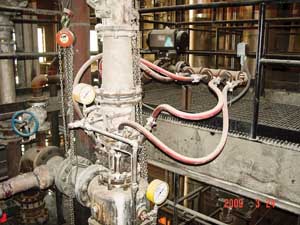
3. Flushed away. The plant designed and installed an automatic flush system to complement the existing OEM fly ash removal equipment. The addition eliminates throat pluggage in the Hydroveyor with PRB-type fly ash. Courtesy: Ameren
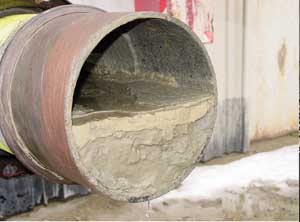
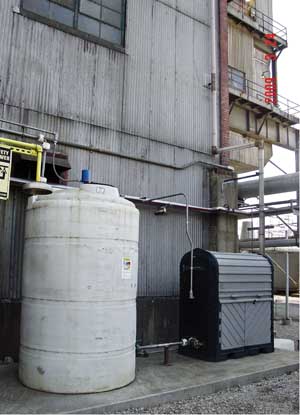
4. Plug blaster. The problem: the fly ash line plugs with PRB-type fly ash (top). The solution: an in-house-developed acid injection system to reduce pH, lower scaling tendencies, and eliminate pluggage (bottom). Courtesy: Ameren
"The training and education of plant staff on the safe handling of PRB fuel and the hazards associated with it was, and still is, a high priority," he said (Figure 5). "The staff in the engineering department, the coal yard operations, and the mechanical maintenance department took the challenge of adding temporary measures to control dust to acceptable standards while plant equipment was upgraded."
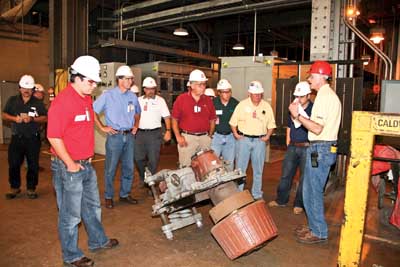
5. A teaching moment. Mike Stewart, plant engineer, explains the benefits of “ribbed pulverizer rolls” during the PRB Coal Users’ Group plant tour. Courtesy: Ameren
Additionally, the plant staff added two articulating irrigation nozzles. They also added one manually operated water cannon to wet the coal-handling and storage area for dust suppression (Figure 6).

6. All wet. Dust control in the coal yard is accomplished by self-pivoting irrigation-type sprinkler heads, which provide coverage of a more than 250-foot radius. Courtesy: Ameren
Musch also pointed out that after the plant began using PRB coal, the boiler furnace area required more frequent use of furnace wall sootblowers. Additionally, the boiler convection passes and backpass on the boiler required more frequent use of long lance sootblowers. Fly ash also tended to accumulate in horizontal tube banks and eventually built up large snowdrifts of fly ash that reduced boiler airflow capability.
"Boiler wall blowers and long lance sootblowers were replaced with new, easier-to-maintain equipment," he said. "Acoustic horns were added to the backpass horizontal tube bank sections as well as the electrostatic precipitator inlet and outlet turning vanes within the boiler gas ducts."
Due to the properties of PRB fly ash, annual explosive cleaning is now required to clean the backpass horizontal tube bank sections of the boiler to remove accumulated fly ash.
Worker Safety: A Top Priority
Due to the increased volatility of PRB coal, the Hutsonville plant had to make some changes to workplace safety practices, Musch said. Here are the adaptations he mentioned:
-
Installation of a remote control mill deluge system to control mill temperatures and be prepared in case of fire.
-
Revision of the coal pulverizer’s operating procedures for unit operators.
-
Advanced training for unit operators for safe pulverizer operations.
-
Selective placement and use of surfactant-based fire extinguishers.
-
Addition of more automatic fire detection and suppression capabilities for coal-handling equipment.
-
Replacement of all plant vacuum hoses with anti-static vacuum hoses.
-
Implementation of an electrical code – compliant coal yard upgrade, which was completed in spring 2008.
"The Hutsonville plant made changes to its regular fire hazard inspections due to the increased volatility of PRB coal compared to other types of coal," he said. "Our plant added new procedures as part of the fire detection and suppression system. We also implemented weekly and monthly inspections of coal-handling equipment for operating permit requirements and safe operations."
Musch noted that during the interview process for the PRBCUG awards, he gained valuable feedback that the plant used to improve the safe and efficient operation of the station. "The recommendations from the members of the PRBCUG review committee included improvements in machine guarding, fire suppression practices, and machine emergency stop enhancements," he said.
More Rigorous Housekeeping Duties
Musch pointed out that the Hutsonville plant also had to make some changes to its regular housekeeping duties as a result of switching to PRB coal:
-
The launch of a new, even more aggressive and accountable cleaning schedule.
-
The initiation of specific times and areas of responsibility on the cleaning schedule.
-
Weekly inspections by an outside corporate safety professional.
-
The addition of wash-down capabilities to the tripper room that utilize in-floor drain collection cans with water induction jets to permit the use of overhead drains. (This new procedure eliminated the costly installation of below-tripper-room-floor drain installation inside the coal bunker system.)
-
An upgrade to the shallow pit reclaim unit so it has wash-down capabilities and has a manually initiated header system.
The Plant’s Formula for Success
Here’s Musch’s opinion of why the Hutsonville Power Station won the PRBCUG’s Top Small Plant award:
-
"The plant staff takes individual ownership in the safe and efficient operation of the facility, and that definitely makes this plant stand out. Each and every person is genuinely concerned about the safety of their coworkers."
-
The plant fuel flexibility conversion took place from the ground up, with all plant personnel participating and taking pride in the accomplishment.
-
The use of nontypical solutions for problematic areas improved the overall reliability of the plant in a very cost-efficient manner.
Leading by Example
As more power plants follow the example set by award-winning facilities like Hutsonvillle, the trend toward smarter ways of handling jobsite risks should produce positive, long-lasting results for workplace safety.
Kudos from our POWER team to the management and staff of Ameren’s Hutsonville Power Station for being named the 2009 PRBCUG Small Plant of the Year.
For further information on the Hutsonville plant or its improvement projects, please contact Greg Musch, production superintendent, at 618-563-1352 or [email protected]. Additional information on the PRBCUG and its awards program is available at www.prbcoals.com.
—Angela Neville, JD is POWER’s senior editor.
